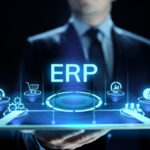Part 1: The Four Key Factors That Affect ERP Costs
Ever wonder why some ERPs cost $300 while some implementations can run into the millions of dollars? The answer is not as simple as it is with other products; more features may not necessarily mean a higher price, higher quality or even a product that will meet your needs. The ERP product must be examined more closely.
Understanding how ERP software solutions are priced will help you make the correct decision for your business. The four key factors when determining the appropriate ERP price are:
1. The View
2. Market Size
3. Degree of Customization
4. IT Requirements
1. The View
This is the first and most important factor in determining the cost of ERP software. The more views the software supports, the more expensive the product and the larger the company the solution is designed to suit. Scalability is also an important consideration.
When you first log into many of the smaller ERP software solutions, you are presented with a view that might feature sales opportunities on the left and cash balances on the right. This is an example of a very wide view. While such a view is relevant for an owner or ERP operator, it is clearly inappropriate for anyone in a 100 person organization. The larger the solution, the more ways it can be segmented to meet the needs of the specific user logging in – at a higher price. As a result of this greater segmentation, large ERP systems are much more role- and process-based than smaller systems.
2. Market Size
The second most important factor is the size of the market for the solution. Solutions designed for a niche market will have higher prices because the potential customer base is smaller. The advantage of such a product is that it is – usually – designed to meet the specific requirements of that particular industry and should contain many of the necessary forms and processes. (A pest control solution might have a field for the type of pest and required protective gear, for example).
A note of caution: Niche ERP solutions are often very limited in critical areas including CRM, purchase orders, accounting, inventory, system admin, and so on. If you do decide to pursue an industry-specific ERP solution, it is extremely important that you also evaluate the presence and capabilities of these other functions. Frequently, the “industry-specific” section is only 10% of the software with the remaining 90% involving common business operations. With this in mind, it is often better – and less expensive – to find a more “general” solution that you can modify to meet your specific needs.
3. Degree of Customization
ERP solutions that cannot be customized should be substantially cheaper than more customizable solutions. Customization requires a team of highly skilled people well versed in both business and technical matters, not only during the initial implementation of the software but on an ongoing basis for support and continued development. While this flexibility is – in many cases – desirable, it comes at the cost of learning, configuration and ongoing support. In general, the greater the human component, the greater the cost of the ERP solution.
4. IT Requirements
This is the least important of the top four key factors when evaluating ERP solutions. While it is true that massively multi-user solutions capable of processing a million transactions a minute will be substantially more expensive than smaller solutions, the most important decision factors should involve those key ERP software facets discussed above that are essential to your company. That selection will in turn drive your technology; it can’t work the other way.
Part 2: Key Rules That Factor into ERP Costs
Understanding how these key factors affect price can help explain the cost of most ERP solutions.
• A solution designed to support a large number of users with very specific job functions in a niche or custom market is going to be very expensive. Most major corporations and government agencies belong to this group.
• A solution designed for a small number of users with a single, wide view will typically be inexpensive. This market is large and customization of these solutions is limited. The packages you can buy off-the-shelf at big box retailers belong to this category.
The above represent the two opposite ends of the spectrum, but you can apply these rules to your situation:
• As your company grows, so will your need to split up job functions into increasingly granular roles. When determining whether a solution is a good fit, calculate the number of different views you require now and in the near-term and compare that with the number of views supported by the software.
• The smaller your industry, the more difficult and expensive it will be to find ERP solutions that meet your industry’s requirements. Furthermore, you may find that while the solutions designed for your industry are good at the 10% that is unique to your industry, they offer poor performance with regards to the other 90% that is common among businesses as discussed in the Market Size section above.
• The greater the need to meet your company’s and/or industry’s specific requirements, the greater the potential need for customization.
• The higher the volume of transactions and the more dispersed your workforce, the greater the cost.
Identifying solutions designed for your company’s current and foreseeable size, evaluating the importance of industry and/or company-specific workflow requirements, weighing the need for customization, and considering the IT aspects of deployment should allow you to quickly narrow the list of potential solutions from dozens to just a handful. It will also ensure that you avoid any major incompatibilities between your needs and your chosen solution. It is also more than likely that your short list will contain similarly priced ERP solutions that will illustrate your position in the pricing spectrum and a starting point for your budgeting requirements.



